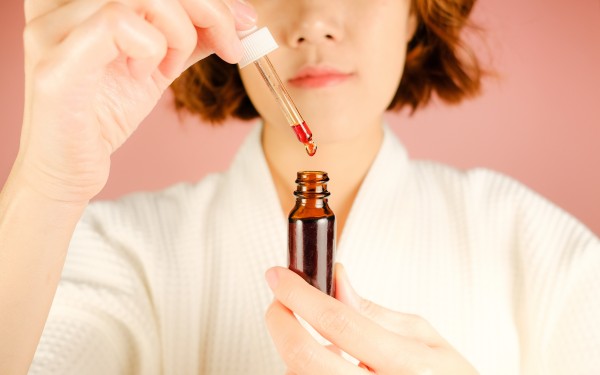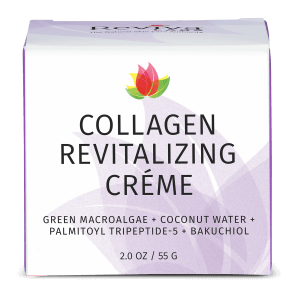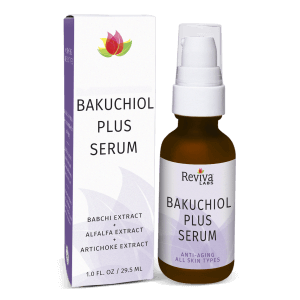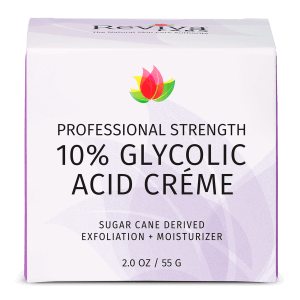Clean Beauty, Ingredients, Skin Care
How does skin change as we age?
Our skin comprises one-sixth of our overall body weight1 and is our largest organ. It is not merely a barrier between us and the environment. It is integral in regulating our body temperature, maintaining hydration, performing sensory functions, aiding circulation, and yes, it is a component of our external immune system. Keeping it healthy and functioning properly is of paramount importance. But all of us grow older and changes in the skin are unavoidable as we age.
Skin starts aging in your 20’s
Until about the age of twenty, our skin is robust, thriving, and youthful in its activity. Most of us don’t think about our skin unless we get sunburn or until we notice the first intrinsic signs of skin aging. However, skin aging is inevitable – and it happens much younger than most of us think. And while the exact timing depends on genetics and lifestyle, skin changes generally progress similarly in all of us.
Beginning at twenty the skin gradually produces about 1% less collagen every year2. Simultaneously, elastin begins to thicken. This is when the “fibrous” substructure of your skin transitions gradually becoming looser and inelastic and more brittle over time. Typically, by age forty, collagen is no longer produced, and inelasticity issues worsen. Therefore, wrinkles and drooping skin become more noticeable in our thirties, forties, and beyond.
During the same period the skin’s exfoliation slows, decreasing by around 28% by the time we reach our thirties. This leads to an accumulation of dead skin cells that can leave skin looking dull and can clog pores while also inhibiting absorption of topical treatments. Combined with the reduction in collagen and elastin, this leads to sagging skin and the formation of wrinkles.
You’ll often encounter discussion in your late twenties and thirties about increasing cell turnover (by removing dead skin cells so younger cells can surface). Weekly exfoliation (chemical or physical), dermaplaning, or using ingredients such as retinols or bakuchiol can help alleviate dead skin accumulation to restore skin’s youthful radiance.
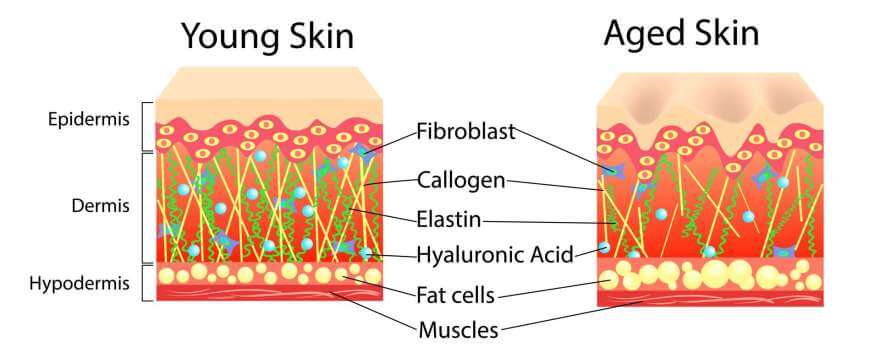
The downhill speeds up in your 30’s
In our thirties moisture transfer from the dermis to the epidermis slows and the subcutaneous fat layers begin to shrink. The skin cells of the epidermis also continue to thin as cells linger longer and become larger but flatter overall. Melanocytes (the pigment-containing cells) also decrease, which combined with thinner skin leads to pale more translucent skin. “Age spots” begin to appear and become more pronounced depending on prior levels of sun exposure.
Intrinsic aging progresses
Older individuals often suffer from dry skin issues due to sebaceous glands producing less oil. This means more trans epidermal water loss and difficulty retaining skin moisture. Dry skin clean lead to inflammation, irritation, and progressive skin conditions such as eczema. Older individuals also tend to sweat less, which complicates body temperature regulation, especially with thinning skin and dermal fat loss.
Thicker creams that offer both emollients and moisturizers along with an occlusive ingredient will be extremely beneficial as your skin naturally become drier. Hyaluronic acid, glycerin, and other humectants will help draw moisture to the skin, while nourishing oils such as sunflower, argan, lanolin, sea buckthorn, hemp, and other oils will aid in replenishing your skin’s natural moisturizing factors (e.g, essential fatty acids (EFAs), ceramides, lipids, etc.).
As skin aging progresses, blood vessels become more fragile, and the thinner more brittle skin leads to more or worse bruising. Older skin also begins to experience localized skin issues, such as rough brown patches (seborrheic keratosis) and skin growths proliferate such as skin tags and warts. Aging skin also repairs itself more slowly.
Everyone will experience skin aging differently
Continual UV exposure will hasten each step of skin aging and lead to long-term accumulation of damage. It’s why those who work outdoors often appear older with more leathery-looking aged skin. Environmental and lifestyle factors can also contribute to more rapid skin aging. Smoking, substance abuse, and even severe stress can excerbate skin aging.
Prevention is key
Overall, how your skin ages depends on many different factors: lifestyle, heredity (genetics), environmental influences, and what levels of prevention and treatment you utilize – and at what age. Living healthy and eating well will help slow skin aging’s progress. Likewise, using preventative skin care, starting in your twenties, and adapting your skin care as you age and help you avoid more severe skin aging outcomes. Intrinsic skin aging can’t be stopped but it can be slowed and lessened.
Correction is possible
Eliminating all signs of aging is likely a quixotic quest but there are realistic options to minimize even the direst situations. Severely damaged or aged skin will require medical intervention, such as peels, resurfacing, or facelifts. For most of us, if we adopted a prevention and treatment skin care routine, we’re able to adapt our skin care regimens to the changes our skin undergoes.
Topical treatments have progressed significantly in recent years. Peptides and skin identical ingredients along with newly discovered botanicals continue to offer a wide range of skin care solutions. No matter what age your skin is or appears. But more importantly, as we age, we need to consider how our skin is changing internally. It’s not enough to simply treat the aesthetic signs of aging – we need to seek solutions to keep our skin healthy – and the earlier we start the better.
Related Reading
- 1 https://www.ncbi.nlm.nih.gov/pmc/articles/PMC3840548/
- 2 https://sites.dartmouth.edu/dujs/2013/01/28/why-does-your-skin-age/
- https://www.webmd.com/beauty/cosmetic-procedures-aging-skin
- https://medlineplus.gov/ency/article/004014.htm




